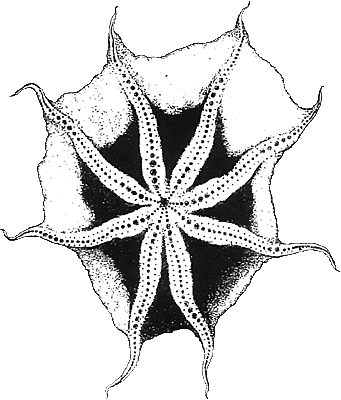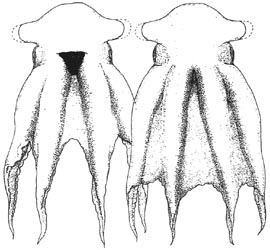Opisthoteuthis hardyi
Roger Villanueva, Michael Vecchione, and Richard E. YoungCharacteristics


Figure. Oral view of O. hardyi, holotype. Drawing from Villanueva et al., 2002.
- Arms
- Arms subequal, 440-480% of ML.
- Arms I with slight increase in thickness.
- Web nodules or web supports absent.
- web more extensive on dorsal arms; Web formula - A=B>C=D>E.
- Arm sucker count 60-67.
- Males with two fields of enlarged suckers present on all arms; largest sucker diameter of distal field approximately equal to that of proximal field.
- Proximal field with suckers 4-9 typically enlarged; suckers 6 or 7 usually largest; all arms with equal enlargement.
- Distal field with usually 9-14 suckers enlarged beginning with sucker numbers 18-19; suckers 22-24 usually largest; all arms with equal enlargement.
- Cirri short; longest 1.7-4.1 mm or 4-9% of ML.
- First cirri appear between suckers 2 and 4.
Comments
More details of the description of Opisthoteuthis hardyi can be found here.
Opisthoteuthis hardyi shares (where males are known) enlarged suckers in both proximal and distal fields that are the same on all arms with O. agassizii, O. bruuni, O. chathamensis and O. grimaldii. It differs from O. agassizii and O. grimaldii in lacking web supports, it differs from O. bruuni in having more enlarged suckers in the distal field (9-14 vs 2-3) and it differs from O. chatamensis in having a unilobular digestive gland and more suckers on each arm (60-67 vs 41-45).
Distribution
Type locality: Near South Georgia Island at 53°18'S, 42°12'W, taken in a pelagic trawl that fished near the ocean floor at 800-1000 m (Villanueva et al., 2003). This species is known only from the type locality.
References
Villanueva, R., Collins, M., Sanchez, P. and N. Voss. 2002. Systematics, distribution and biology of the cirrate octopods of the genus Opisthoteuthis (Mollusca, Cephalopoda) in the Atlantic Ocean, with description of two new species. Bulletin of Marine Science 71(2):933-985.
Title Illustrations

| Scientific Name | Opisthoteuthis hardyi |
|---|---|
| Comments | Fins were strongly contracted on preservation, dotted lines show expected profile. |
| Reference | Villanueva, R., Collins, M., Sanchez, P. and N. Voss. 2002. Systematics, distribution and biology of the cirrate octopods of the genus Opisthoteuthis (Mollusca, Cephalopoda) in the Atlantic Ocean, with description of two new species. Bulletin of Marine Science 71(2):933-985. |
| Acknowledgements | Printed with permission from the Bulletin of Marine Science. |
| Sex | Male |
| Life Cycle Stage | Mature |
| View | Ventral and dorsal |
| Size | 45 mm ML |
| Type | Holotype |
| Copyright | © 2002 Bulletin of Marine Science |
About This Page

Instituto de Ciencias del Mar (CSIC), Barcelona, Spain

National Museum of Natural History, Washington, D. C. , USA

University of Hawaii, Honolulu, HI, USA
Page copyright © 2016 , , and
All Rights Reserved.
- First online 13 May 2003
Citing this page:
Villanueva, Roger, Michael Vecchione, and Richard E. Young. 2003. Opisthoteuthis hardyi . Version 13 May 2003 (under construction). http://tolweb.org/Opisthoteuthis_hardyi/20160/2003.05.13 in The Tree of Life Web Project, http://tolweb.org/








 Go to quick links
Go to quick search
Go to navigation for this section of the ToL site
Go to detailed links for the ToL site
Go to quick links
Go to quick search
Go to navigation for this section of the ToL site
Go to detailed links for the ToL site